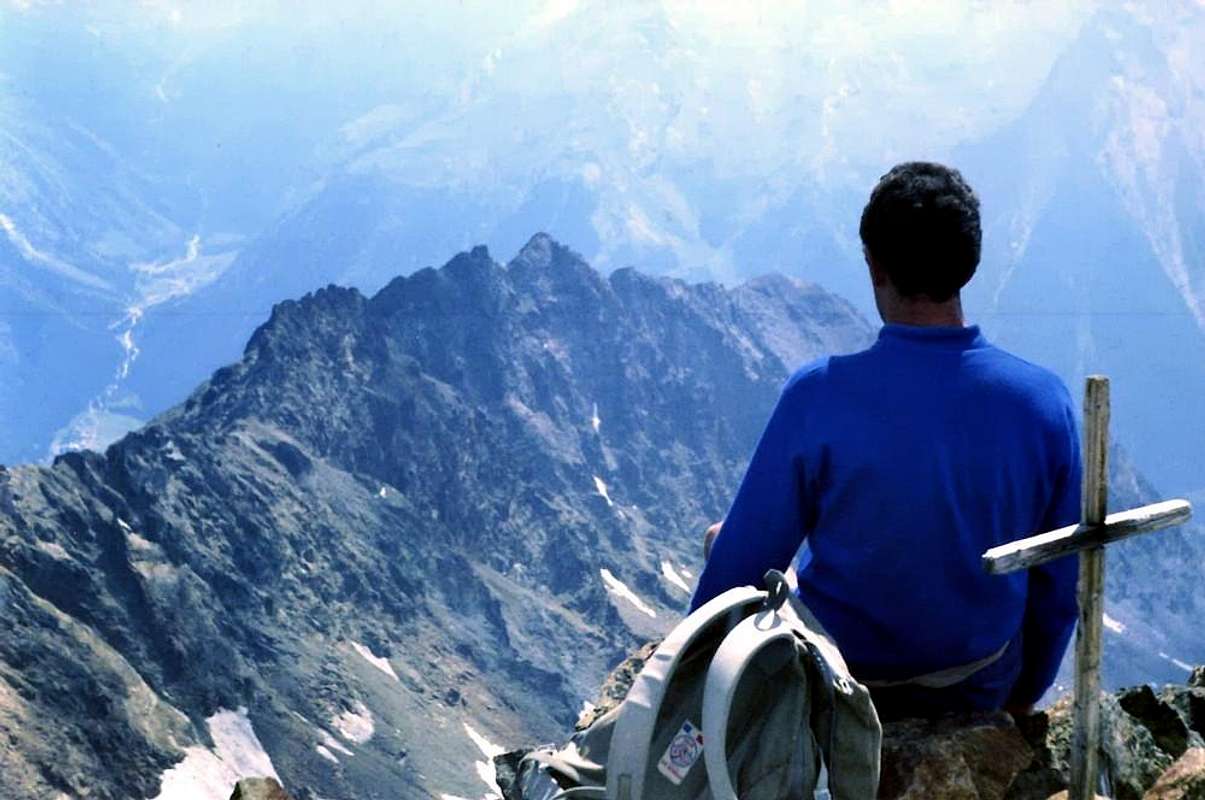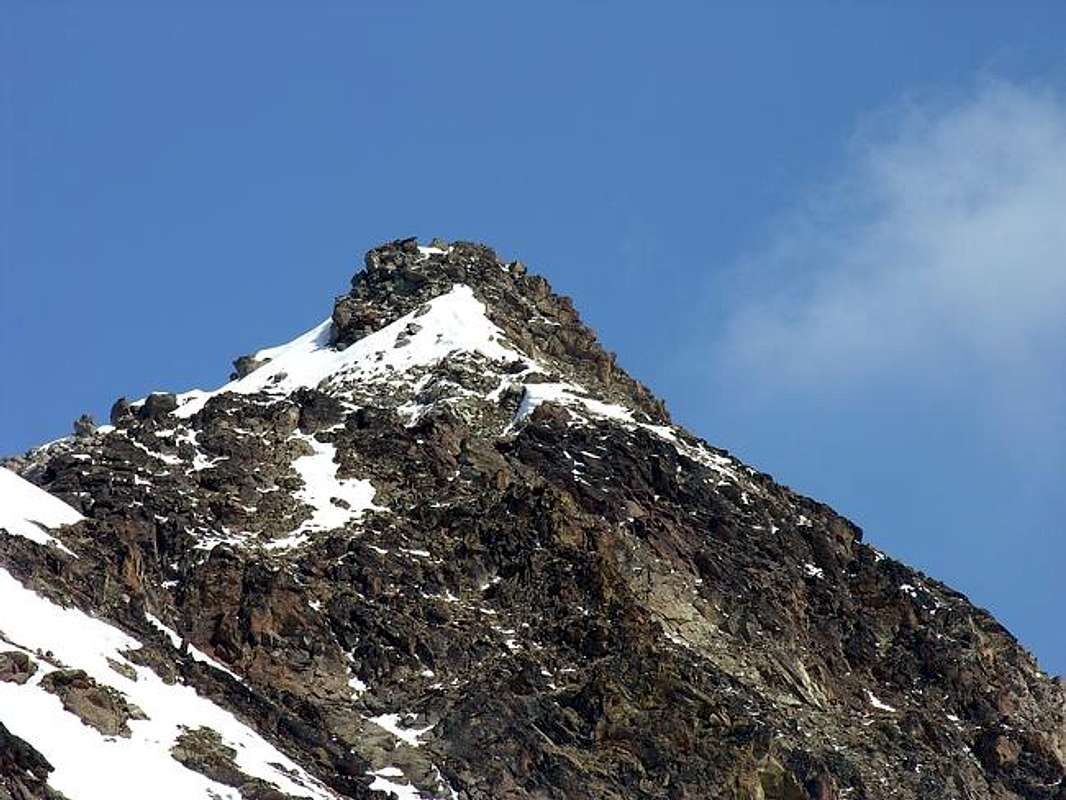-
 3076 Hits
3076 Hits
-
 81.84% Score
81.84% Score
-
 14 Votes
14 Votes
|
|
Mountain/Rock |
|---|---|
|
|
45.64420°N / 7.36790°E |
|
|
Mountaineering, Trad Climbing |
|
|
Spring, Summer, Fall, Winter |
|
|
10600 ft / 3231 m |
|
|
Note
|
La montagna chiama i suoi figli, ed essi rispondono fedelmente al suo appello… Osvaldo Cardellina, Diario alpinistico, 1964-65 Page texts: @ OsvaldoCardellina "Osva", passed away on May 2, 2022. Page owners: Christian Cardellina e Osvaldo Cardellina. Any updates from September 12, 2022: Antonio Giani, page administrator, friend and climbing companion. Testi della pagina: @ OsvaldoCardellina "Osva", scomparso il 2 maggio 2022. Proprietari pagina: Christian Cardellina e Osvaldo Cardellina. Eventuali aggiornamenti dal 12 settembre 2022: Antonio Giani, amministratore della pagina, amico e compagno di salite. |
Sharp & Cut Overview

Small Research Historical-Toponomastic
This triple Mountain is referred to as Punte Coppi in all the Old Maps. At least in the after-cards ""Group of Gran Paradiso"", Scale 1:50.000, published in 1908 by I.G.M., according to the findings of the Engineer Paganini and under the aegis of the Sections of Turin and Aosta. The same was inserted to the Bulletin XXXIX° with the generic abbreviation for "Charter of C.A.I.". Happened to the "Charter Sardinian 1856-58" as the same Bulletin 1908, n° 72. However in a large color paper in 1878 or 1988 (?), I have, in this coastal existed, from the bottom, only these names: Cornas dell'Arpisson (2.340m), T. Châplane (2.673m), P. d'Arpisson S. (+ 2.823m) and unnamed, but granted as opposed to the North Altitude (3.033m), easily attributable to the current and with evidence of the presence of a Cross on Antetop South, however, listed or too defect or corresponding to a lower, than the current, altitude on the Southwest Ridge. The next stretch, that is what the Pila Southwest bypasses the three Pointes Coupées to reach the Pila Northeast Pass shows only the generic name of P. Vachères and Col de Pila for the second of the two, without giving both a height; in fact a Comba Vachère still exists today at the foot of the Southern Slope of the Tsaplana and between the two Torrents de Gimillan and Tarambel. Following the massive Tower Arpisson is not even reported as name and height as well as the graphical representation is unsatisfactory; perhaps, we say, because Gimillan not see her, and certainly in those days did not care a lot for if it is true that has been rising "downhill" from Garin Peak from roped English Compton-Richards with Guides Swiss Alois and Siegfried Burgener in 1897, preceded by just seven days by George Yield with his Guide Valtournanche François Pession, in ascent August 13th. Disappears Col Fleurie, as by positioning the Map, and it seems most quoted indicate the Col de Pila and you have to get to the P. Fiorita (3.252m), here rightly feminine as named by the underlying Combe de la Chaz Fleurie; the last stretch, properly drawn South, leading to P. Garin (3.447m). After all this analysis, the Mystery has not been solved; we only know that the Tips were generically Vachères, but the snag of this Punta Coppi is still not addressed and much less solved. We must continue the "path mapping" and get to the I.G.M. campaign raised cartographic, with 25.000 tablets, of 1930 to 1932 and 1973 to begin to understand something. The Cartographer era, certainly questioning the farmer-herder Gimillan, you will be heard responding: "Les Pointes Coupì", doubling, as the local dialect, is the pe then "Pointes Couppì", whence, by the ear is not accustomed to the language, in a short time to "Tips Coppi". Nor can one speak of a dedication to the famous Italian cyclist Fausto Coppi, which in those days he was 11 or 13 years (it was 1919). Same goes for Garin that there is a dedication to the cyclist of Aosta Valley Arvier Maurice Garin won the first Tour de France, but it seems that comes from the top or Gar. But we will discuss later. We must instead wait until December 1978 when in "Guide of Monte Emilius" is pointed out the glaring error on page 94 where it says: "The more easily spot the place name was, incidentally as the appearance of the tips suggests and how well it is supported by analogies to Val de Cogne, be to Pointes Coupì or Coupées, also "Tips Cut"; seems so much more sense to bring the name of fairness on the tracks matching the same, if anything, with that "Arpisson" specification to distinguish themselves from other Coupé existing in the same valley". See Pointe Coupée in close Group of Penne Blanche and various Coupé in against Valnontey. Thus, and with pleasure, it has been able to in the new Cart "Gran Paradiso Cogne etc. MAP" to 25.000 in 2011, has accepted the correct name of "Pointe Coupée". In itself, however, are "touched up" with 3.168 meters for the same, 3.140m to Col Pila Northeast, 3.227m to the Tower of Arpisson, 3.197m to the Fiorito Pass, here in the masculine, and 3.218m to the nearby Tips Lavà; Punta Fiorito 3.260m and 3.461m even for the Vertex Peak Garin. An assessment with which I fully agree, as various empirical analyzes performed, because almost certainly derived from satellite measurements. As for the name of Garin instead, notwithstanding the assumption in "Who knows why they call it A Crack in the vocabulary of the mountains of Aosta Valley" C.A.I. Aosta Valley with texts by Umberto Pelazza and by Marica Forcellini, Edit. 2011, states on page 132: "They return the names of the sons rocks: Gar in Punta Garin; ...". Undoubted talents place names which the Author of a very good Pelazza, we would like to observe, however, without the will claim to have hit the mark, that perhaps this is a definition too "noble" for what was probably the only limitation of an old farmhouse, confirmed by the "Low Garin" indicating the transition to the concomitant Upper Alpage Arbolle on the routes for Comboé and Pila. Waiting for serious research in municipal offices or parishes, of this Pelazza remains however the only real plausible hypothesis, while my remains, until proven otherwise, only a simple observation. More in over 200 years of Mountaineering History we never found, even at the tutelary deity corresponding to Abbé Joseph Maria Henry. For other names Arpisson comes from arp, ie Alp and some other type Côtes Lavà (steep grassy coasts and "washed out"), was assigned by the work of 1978 and now accepted in the Charter of 2011 Cogne-Valsavarenche. Is generally directed to a location below: for example, over Lavà, Bessey, Tsavanis, Tsa Setze, Lussert etc .; while remaining inside Group Monte Emilius.
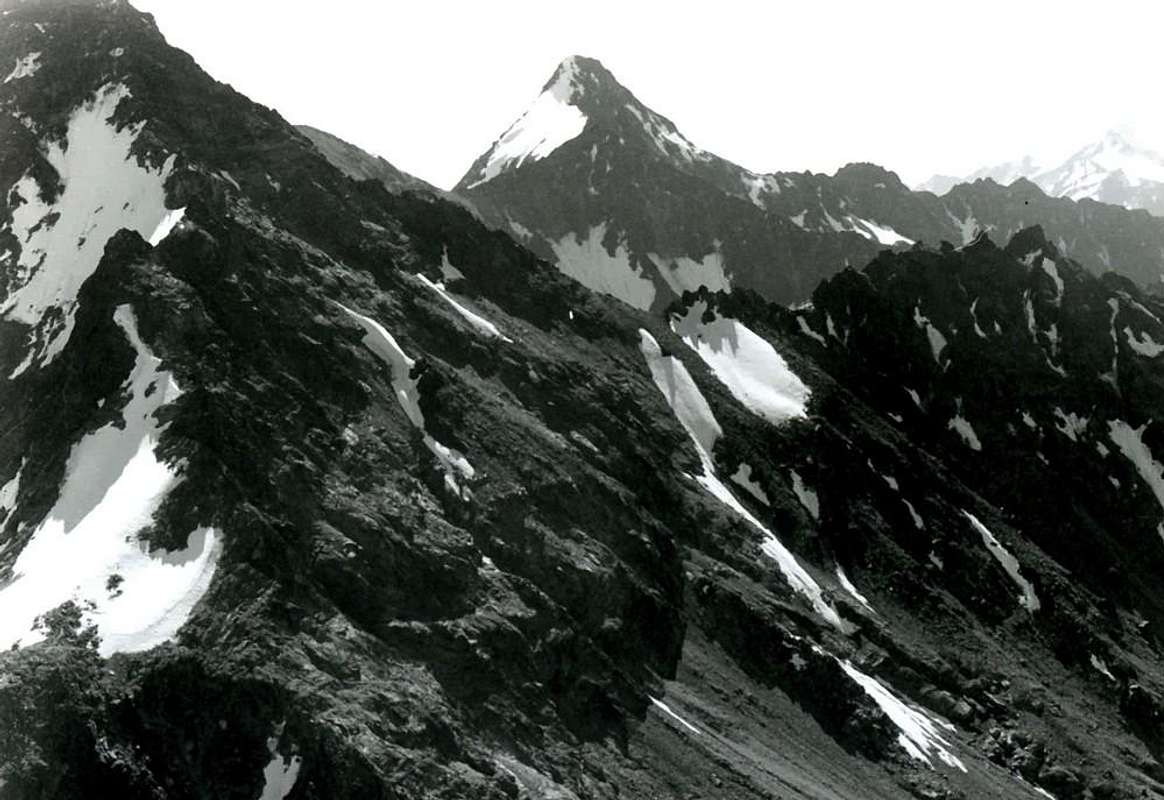
Questa triplice Sommità vien denominata come Punte Coppi in tutte le Vecchie Mappe. Almeno in quelle successive alla Carte "Gruppo del Gran Paradiso", scala 1:50.000, pubblicata nel 1908 dallo I.G.M., in base ai rilievi dell'Ingegner Paganini e sotto l'egida delle Sezioni di Torino ed Aosta. La medesima veniva inserita al Bollettino XXXIX° con la generica abbreviazione di "Carta del C.A.I.". Succedeva alla "Carta Sarda 1856-58" come da medesimo Bollettino 1908, n. 72. Comunque in una grande carta a colori del 1878 o 1988 (?), in mio possesso, in questa costiera esistevano, partendo dal basso, solo questi toponimi: Cornas dell'Arpisson (2.340 m), T. Châplane (2.673 m), P. d'Arpisson Sud (+ 2.823 m) e senza nome, ma scontato per contrapposizione Nord la Quota (3.033 m), facilmente riconducibili all'attuali e con testimonianza della presenza d'una Croce sull'Antecima Sud, peraltro o quotata troppo in difetto o corrispondente ad una quota inferiore, rispetto all'odierna, sulla Cresta Sudovest. Il tratto successivo, cioé quello che dal Col di Pila Sudovest scavalca le tre Pointes Coupées per raggiungere quello di Nordest riporta esclusivamente il toponimo generico di P. Vachères e Col de Pila per il secondo dei due, senza dar ad entrambi un'altezza; in effetti una Comba Vachère esiste ancora oggigiorno ai piedi del Versante Meridionale della Tsaplana, compresa tra i due Torrents de Gimillan e di Tarambel. A seguire la poderosa Torre di Arpisson non vien neppur segnalata sia di nome che d'altezza ed anche la rappresentazione grafica lascia a desiderare; forse, diciamo noi, perché da Gimillan non la si vede e certamente a quei tempi non interessava un gran ché, se é vero che é stata salita "in discesa" dalla Garin dalle cordata inglese Compton-Richards con le Guide svizzere Alois e Siegfried Burgener nel 1897, preceduta di soli sette giorni da George Yeld con la sua Guida di Valtournanche François Pession, in salita il 13 di Agosto. Scompare il Col Fleurie che, come da posizionamento sulla Carta, pare più indicar il citato Col de Pila e bisogna arrivare alla P. Fiorita (3.252 m), qui giustamente al femminile poiché porta il nome dalla sottostante Combe de la Chaz Fleurie; l'ultimo tratto, correttamente disegnato a Sud, conduce alla P. Garin (3.447 m). Dopo tutta quest'analisi, il Mistero non é stato risolto; sappiamo soltanto che genericamente erano le Punte Vachères, ma il busillis di questa Punta Coppi non viene ancora affrontato e men che meno risolto. Bisogna proseguire il "cammino cartografico" ed arrivare alle levate di campagna I.G.M., con tavolette al 25.000, del 1930-1932 e 1973 per iniziare a comprendere qualcosa. Il Cartografo dell'epoca, sicuramente interrogando il contadino-pastore di Gimillan, si sarà sentito rispondere: "Les Pointes Coupì", raddoppiando, come é nel dialetto locale, la p e quindi "Pointes Couppì", donde, per un orecchio non assuefatto all'idioma, in breve tempo a "Punte Coppi". Neppur si può parlar d'una dedica al famoso ciclista italiano Fausto Coppi, che a quei tempi aveva 11 o 13 anni (era del 1919). Stesso discorso vale per Garin che non é una dedica al ciclista valdostano d'Arvier Maurice Garin vincitore del primo Tour de France, ma par derivi da Gar ossia Sommità. Ma di questo discuteremo più avanti. Bisogna invece attendere Dicembre 1978 quando in "Guida del Monte Emilius" vien fatto notare il madornale errore, ove a pagina 94 si dice: "Più facilmente in loco il toponimo doveva, come daltronde l'aspetto delle punte induce a pensare e come pure é sostenuto da analogie per la Val di Cogne, essere quello di Pointes Coupì o Coupées, ovverossia Punte Tagliate; pare quindi alquanto più sensato ricondurre il toponimo sui binari della correttezza abbinandolo, semmai, con quel "di Arpisson" di specificazione per distinguerle da altri Coupé esistenti nella stessa vallata". Vedi Pointe Coupée nel vicino Gruppo del Penne Blanche ed i vari Coupè nella dirimpettaia Valnontey. Così, e con piacere, si é potuto che nella nuova Carta "Gran Paradiso Cogne ecc. MAP" al 25.000 del 2011 si é accettato il corretto toponimo di "Punta Coupée". Nella stessa vengono però "ritoccate" con 3.168 metri per la medesima, 3.140 m per il Col di Pila Nordest, 3.227 m per la Torre di Arpisson, 3.197 m per il Colle Fiorito, qui al maschile, e 3.218 m per le vicine Punte di Lavà; la Punta Fiorito 3.260 m ed addirittura 3.461 m per il vertice massimo della Punta Garin. Una valutazione che mi trova completamente daccordo, come da varie analisi empiriche effettuate, anche perché quasi certamente deriva da misurazione satellitare. Per quanto concerne il toponimo di Garin invece, nonostante quanto presupposto in "Chissà perché si chiama così A spasso nel vocabolario dei monti valdostani" del C.A.I. Valle di Aosta con testi di Umberto Pelazza ed a cura di Marica Forcellini, Edit. 2011, si legge a pagina 132: "Ritornano i toponimi figli delle rocce: Gar nella Punta Garin; ...". Indiscusse le doti toponomastiche d'un Autore quale il bravissimo Pelazza, ci permettiam però d'osservare, senza voler pretendere d'avere colto nel segno, che forse è questa una definizione troppo "nobile" per quella che probabilmente era soltanto la limitazione d'un antico podere, confermata anche da quel "Bassa di Garin" indicante il passaggio verso il concomitante Alto Alpeggio di Arbolle sulle vie per Comboé e Pila. In attesa di serie ricerche nelle sedi comunali o nelle parrocchie, questa del Pelazza rimane però l'unica vera ipotesi plausibile, mentre la mia rimane, fino a prova contraria, esclusivamente semplice osservazione. Altro in oltre 200 anni di Storia Alpinistica non abbiamo mai trovato, nemmeno presso quel Nume tutelare che corrisponde all'Abbé Joseph Maria Henry. Per gli altri toponimi Arpisson deriva da arp, cioé Alpe e qualche altro, tipo Côtes Lavà (ripide coste erbose e "slavate"), é stato assegnato dall'opera del 1978 ed ora accettato nella Carta 2011 di Cogne-Valsavarenche. Generalmente é rivolto ad una località sottostante: ad esempio, oltre Lavà, Bessey, Tsavanis, Tsa Setze, Lussert ecc.; sempre restando all'interno del Gruppo del Monte Emilius.
First Ascents
- First on the Summit: Osvaldo Cardellina and Giuseppe Lamazzi; Jan 08th, 1978, in ascent by Southwest Crest and traverse to Pila NE Pass.
- In winter: Osvaldo Cardellina and Giuseppe Lamazzi; Jan 08th, 1978, with descent from NE Pass by Eastern Couloir to Pila Alp in Grauson Vallon.
- South-southwest Ridge: Osvaldo Cardellina and Giuseppe Lamazzi; Jan 08th, 1978, in ascent by Tsaplana to Pila SW Hill and traverse to Pila NE Pass.
- West Wall (Western Rib of Southwestern Top): Osvaldo Cardellina, lone; May 15th, 2008, from Gimillan, Arpisson, Pian di Bessey middle Tableland.
- Northwest Face (Northwest Face of Southwestern Summit): Osvaldo Cardellina, lone; May 11th, 2008, from Gimillan, Arpisson, Pian di Bessey.
- North-northeast Crest: Osvaldo Cardellina and Giuseppe Lamazzi; Jan 08th, 1978, in descent from Northeast Summit to Pila NE Pass.
- Great traverse (Punta di Arpisson, through Southwest Ridge and subsequent traverse towards Pointes Coupées-Arpisson Tower-Punte di Lavà-Punta Fleurie also Fiorito-Pic Garin): Osvaldo Cardellina and Camillo Roberto Ferronato; Sep 17th, 1978, in ascent from Gimillan to small saddle 2.317 meters, below "Arpisson Cornass".
- Eastern Slope (to SW Top): Alessandro Cardellina, Osvaldo Cardellina, Roy Cardellina; Aug 12th, 1992, in ascent from Gimillan 's Hamlet, Truc-Cretettaz, Perché Alp, descent towards Punta di Arpisson-Tsaplana Summit and from this to Gimillan.
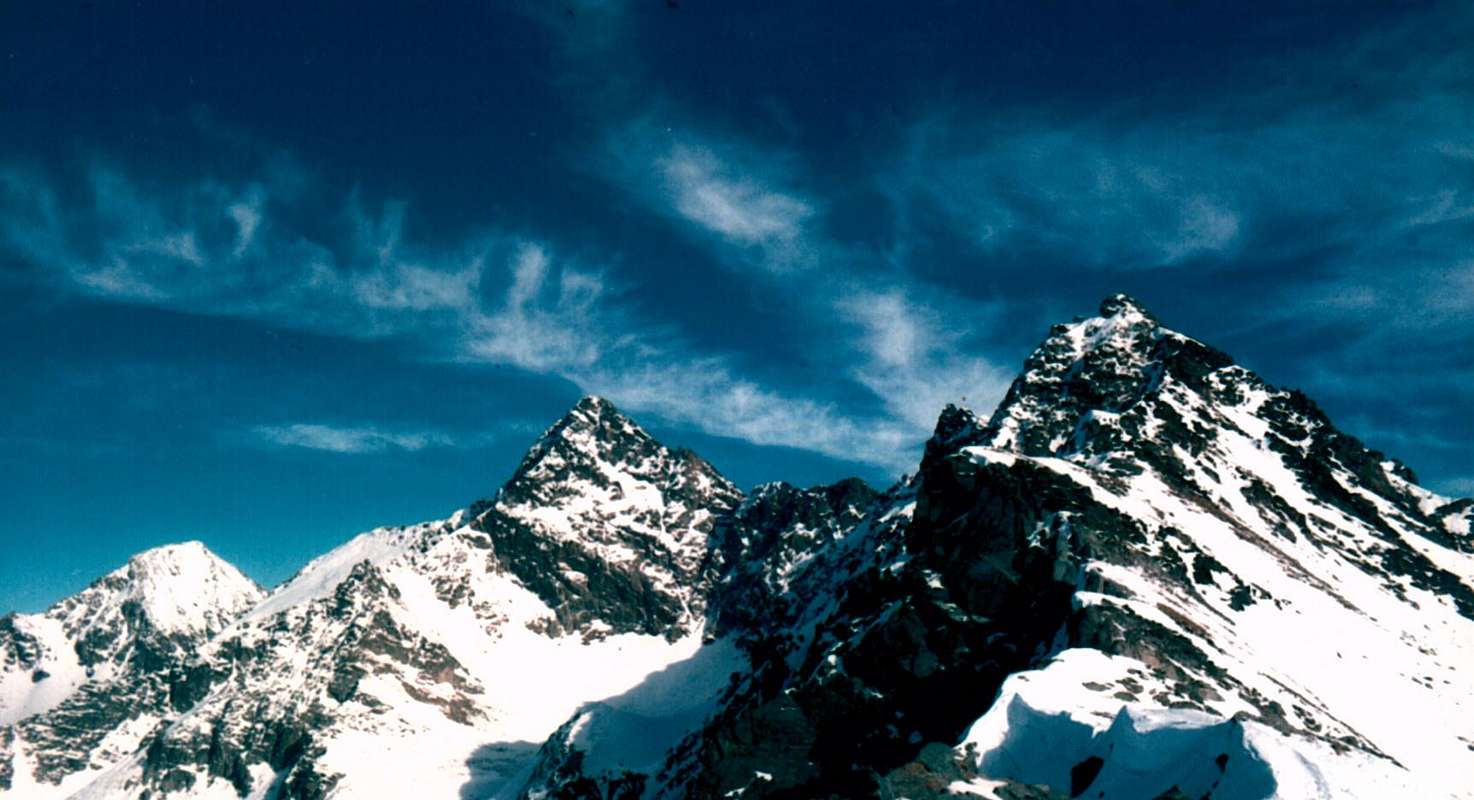
Getting There
BY CAR:
- From Turin or Milan: Motorway A5. Exit in Aosta Ovest. Drive to the near Aymavilles; follow in the direction of Cogne Valley. Or Exit Aosta East to Gr. Brissogne and St. Marcel. From Switzerland: through the Grand St. Bernard Tunnel or the homonym Pass). Drive to Aosta, then follow Courmayeur direction on SS.26. Just after Sarre, turn to the left, in the direction of Cogne Valley, the main side valley in the South after the City of Aosta.
- From France: through Mont Blanc Tunnel or Petit St. Bernard Pass). It isn't necessary to enter in Motorway A5, you can drive through SS.26 Aosta direction. Before arriving at the Village of Sarre, follow the sign and turn right towards the Valley of Cogne.
- Specific Roads After Aymavilles Municipality, the SR.47 crosses the Villages of Vieyes (1.158m; ancient small Sainct Grat Church with various frescoes), Epinel (1.436m) and Crétaz (1.534m) and after about 25 Km. arrives at Cogne (1.534m; important Seat of P.N.G.P. since 1922). Follow the road signs for Gimillan and Lillaz (renowned three waterfalls); arrived at a round-about, recently built in proximity of the St. Anthony Chapel, go left along the scenic route leading to the small Villages of Montroz (1.702m), Gimillan (1.787m); 1,5 and 3 Km. after Cogne Center. Usually no parking problem neeighbor the bell tower of a little chapel in center (ten seats for cars; stone fountain below the bell tower), also near the bridge above Gimillan Torrent (small parking in soil nearby the asphalt road).
BY CAR:
- Aeroporto "Corrado Gex" Saint Christophe (Aosta).
Approaches

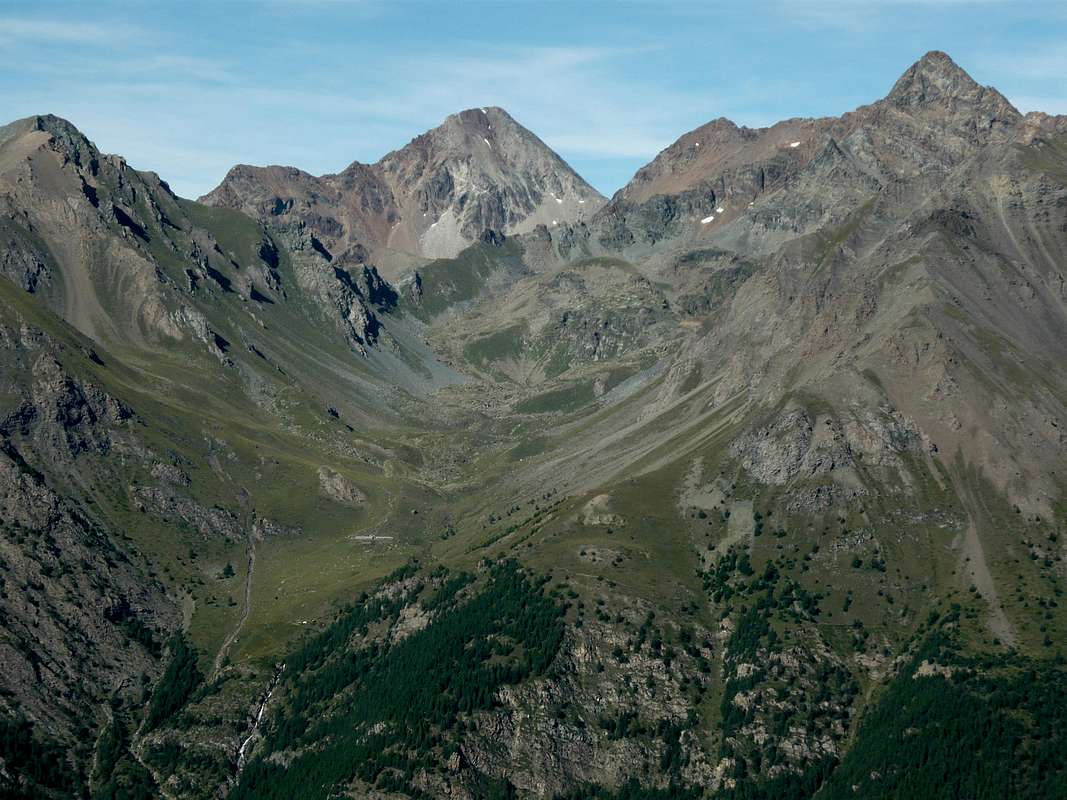
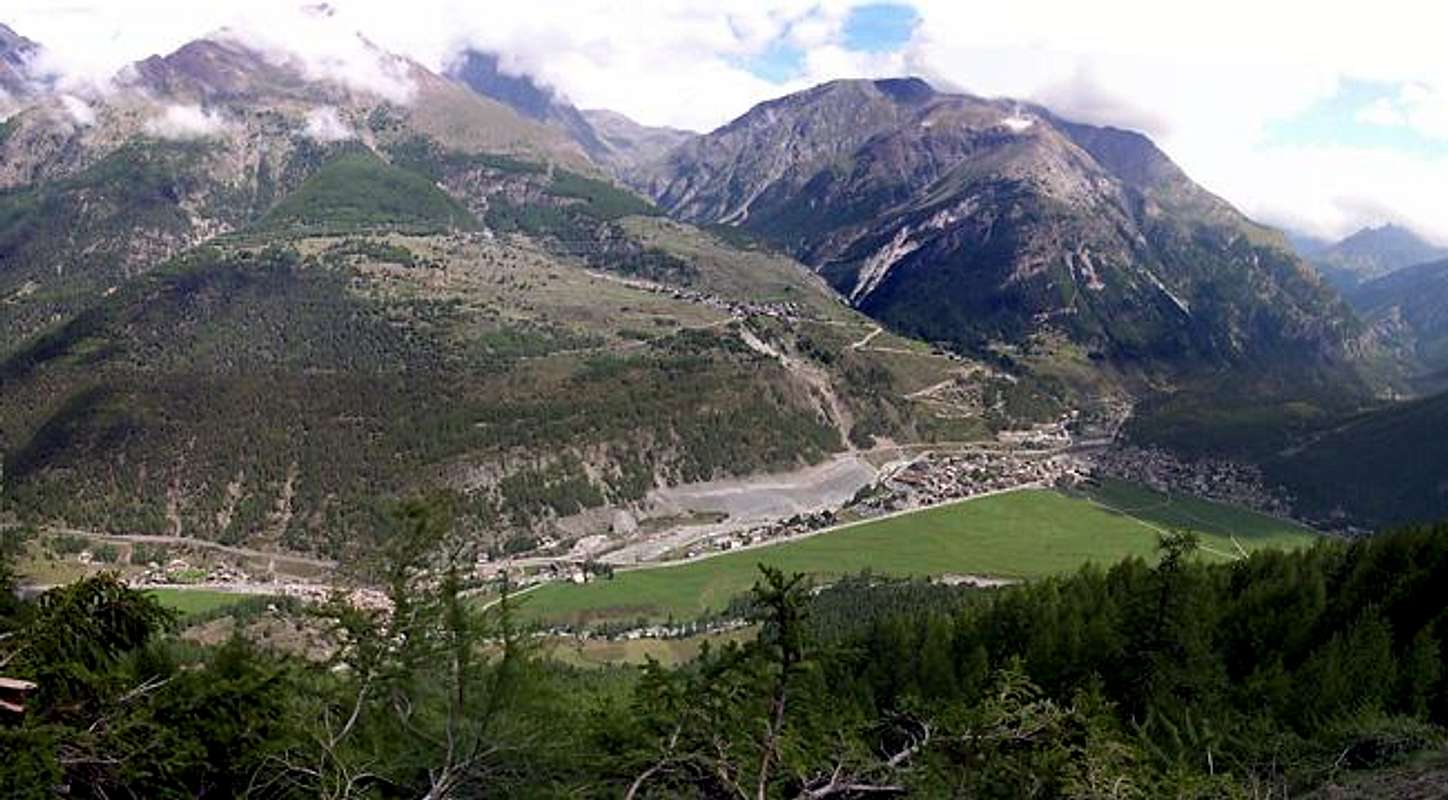
Routes

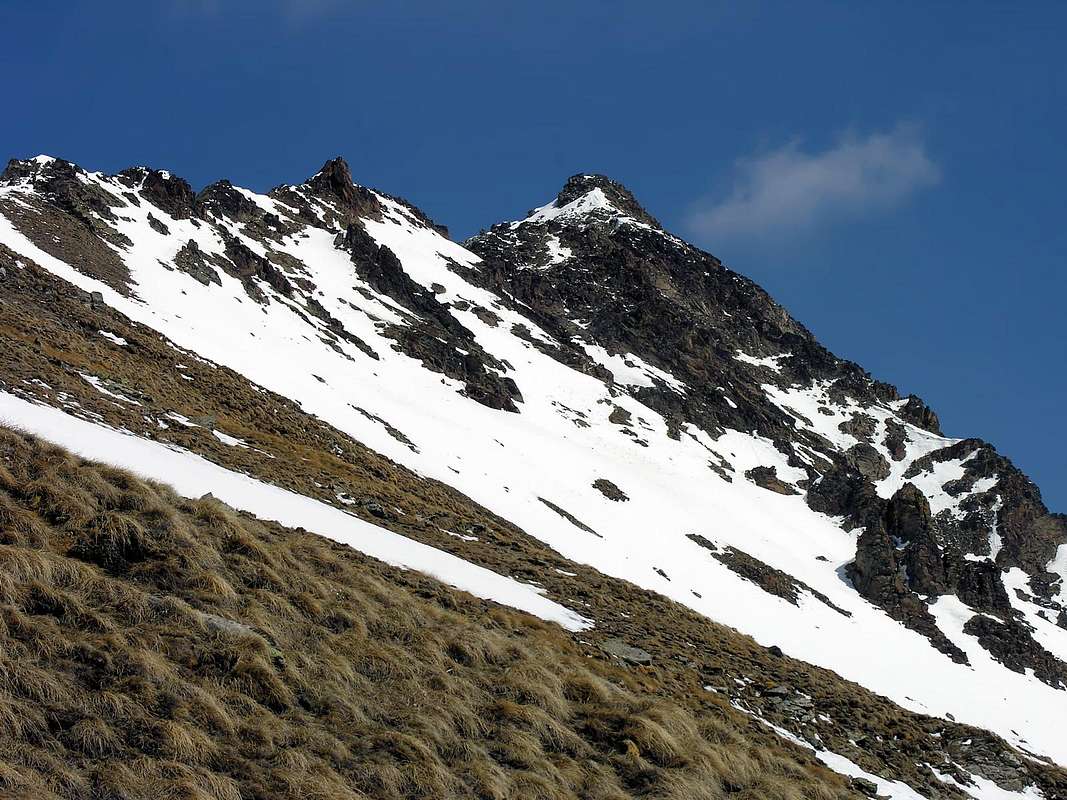
Mountain Condition
- Meteo: you can find all the needed informations at the official site of the Valle d'Aosta Region: Valle d'Aosta Meteo
Books and Maps
- "80 itinerari di Escursionismo Alpinismo e Sci Alpinismo in Valle d'Aosta", di Osvaldo Cardellina, Ed. Musumeci, Giugno 1977 (in Italian); seconda Ed. Luglio 1981; terza Ed. Luglio 1984; (in French), prima Ed. Febbraio 1978; seconda Ed. Marzo 1980.
- "Guida del Monte Emilius" di Osvaldo Cardellina Editore in collaborazione con il Club Alpino Italiano Sezione di Aosta Dicembre 1978.
- "Guida dei Monti d'Italia – Emilius-Rosa dei Banchi-Parco del Mont Avic" di Giulio Berutto e Lino Fornelli - Club Alpino Italiano/Touring Club Italiano, Marzo 2005.
- "Diari Alpinistici" di Osvaldo Cardellina e Indice Generale accompagnato da Schedario Relazioni Ascensioni 1964-2019 (unpublished).
- Kompass Gran Paradiso Valle d'Aosta "Sentieri e rifugi-Carta turistica" 1:50000.
- L'Escursionista "Valle di Cogne Carta dei Sentieri" (n° 10) 1:25.000.
- L'Escursionista "Tour de la Vallée de Cogne Grand Paradis" Carta dei sentieri 1:25.000.
- IGC-Istituto Geografico Centrale "Gran Paradiso La Grivola Cogne" Carta 1:25000.
- Hapax "Les Sentiers" Comunità Montana Monte Emilius luglio 2000 1:25.000.
Important Information
- REGIONE AUTONOMA VALLE D'AOSTA the official site.
- FONDAZIONE MONTAGNA SICURA Villa Cameron, località Villard de la Palud n° 1 Courmayeur (AO) Tel: 39 0165 897602 - Fax: 39 0165 897647.
- SOCIETA' GUIDE ALPINE DI COGNE Tel. 347/9473526 – 328/1373728.
- A.I.NE.VA. (Associazione Interregionale Neve e Valanghe).
- A.IA.T. Cogne Gran Paradis via Bourgeois n° 34 Tel. 0165-74040. E-mail: aiat@cogne.org
- Ezio Sport articoli sportivi - via Bourgeois n° 64 Tel. 0165-74204.
Useful numbers
- Soccorso Alpino Cogne (SAR) Tel. 3482685406.
- Protezione Civile Valdostana località Aeroporto n° 7/A Saint Christophe (Ao) Tel. 0165-238222.
- Bollettino Meteo (weather info) Tel. 0165-44113.
- Unità Operativa di Soccorso Sanitario Tel. 118.


















